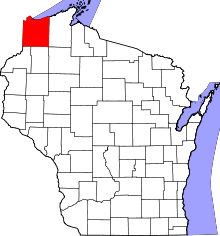Fond du Lac Indian Reservation

The Fond du Lac Indian Reservation (or Nah-Gah-Chi-Wa-Nong (Nagaajiwanaang in the Double Vowel orthography), meaning "Where the current is blocked" in the Ojibwe language) is an Indian reservation in northern Minnesota near Cloquet in Carlton and Saint Louis counties. Off-reservation holdings are located across the state in Douglas County, in the northwest corner of Wisconsin. The total land area of these tribal lands is 153.8375 square miles (398.437 km2). It is the land-base for the Fond du Lac Band of Lake Superior Chippewa. Before the establishment of this reservation, the Fond du Lac Band of Lake Superior Chippewa were located at the head of Lake Superior, closer to the mouth of the Saint Louis River, where Duluth has developed.
History
The tribe ceded land to the US as part of an 1837 treaty along with other Ojibwa bands; the lands were located mainly from east-central Minnesota to north-central Wisconsin. Later, as part of the Treaty of La Pointe in 1842, the Fond du Lac Band and other Ojibwa tribes ceded large tracts of land located mainly in the Lake Superior watershed in Wisconsin and the western Upper Peninsula of Michigan. As part of an 1854 treaty, the tribe and the Lake Superior Band of Chippewa (largely situated along the northern shore of Lake Superior in Minnesota) ceded more land to the US.
Under this 1854 treaty, the US established the Fond du Lac Indian Reservation farther up the Saint Louis River, at its present location. The original Nagaajiwanaang Reservation was 1.25 times the current size. In treaty discussions the US representatives were recorded as promising the inclusion of the Perch and Big lakes, but these were excluded from the original reservation. Its boundaries extended westward to the western boundaries of the 1854 Ceded Territory. Upon appeal by the tribe, the US extended the reservation boundaries southward to include the two said lakes, but as a concession, the tribe had to agree to a reduction in the western boundaries, which were placed at the current location.
It also established a reservation for the Lake Superior Band of Chippewa.
Government
The FDL adopted a written constitution with an elected government. Its tribal council has x members, who serve staggered terms.
The FDL operates social services, tribal housing, a tribal police force, a natural resource building, a gas station, three community centers, and a private health clinic and pharmacy called Min No Aya Win Health Center. The tribe also operates two satellite health clinics, one in Duluth, named The Center for American Indian Resources (CAIR), and another in Minneapolis, the Mashkiki Waakaaigan Pharmacy (Medicine House). It has numerous members who live in these urban areas.
Economy
The tribe owns two casinos: Black Bear Casino in Carlton, Minnesota and Fond du Luth Casino in Duluth.
Communities
- Big Lake (in Perch Lake Township)
- Brookston
- Cloquet (part)
- Mahnomen (in Brevator Township)
Townships
- Arrowhead Township (part)
- Brevator Township (part)
- Brookston (city not included in any other township)
- Cloquet (part; city not included in any other township)
- Culver Township (part)
- North Carlton unorganized territory (part)
- Perch Lake Township
- Stoney Brook Township (most)
- Twin Lakes Township (part)
See also
References
- Fond du Lac Reservation and Off-Reservation Trust Land, Minnesota/Wisconsin, United States Census Bureau
External links
- Fond du Lac Reservation
- 2000 US Census Tract Map for the Fond du Lac Reservation (T1125)
- Digital copy of the 1854 Treaty establishing the Fond du Lac Reservation
- Digital copy of the letter requesting to modify the Fond du Lac Reservation
- Digital copy of the Executive Order modifying the Fond du Lac Reservation
- Black Bear Casino Resort
Coordinates: 46°45′34″N 92°36′50″W / 46.75944°N 92.61389°W


